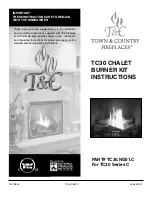
FUEL
MAINTENANCE
PAGE 16
BURN RECOMMENDED FUEL
This appliance is approved for use with wood only. Use
only natural dry untreated wood (see
Important Warn-
ings
, page 2, #10). Do not burn particleboard scraps or
pressed logs using bonding agents because they can
produce conditions which will deteriorate metal. Green or
uncured wood does not work well as fuel, and can cause
increased creosote buildups. The value of green wood as
a source of heat is limited. Do not overload or use kin-
dling wood or mill ends as primary fuel as this may cause
overfiring. Overfiring is a condition where excessive tem-
peratures are reached, beyond the design capabilities of
the stove. The damage that occurs from overfiring is not
covered under the stove warranty.
WARNING: BURNING IMPROPER FUEL (I.E. CHAR-
COAL) CAN RESULT IN
CARBON MONOXIDE POI-
SONING WHICH MAY LEAD TO DEATH!
CARBON MONOXIDE POISONING - EARLY
SIGNS
OF CARBON MONOXIDE POISONING RESEMBLES
THE FLU WITH HEADACHES, DIZZINESS, OR NAU-
SEA. IF YOU HAVE THESE SIGNS, GET FRESH AIR
AT ONCE! HAVE THE HEATER INSPECTED BY A
QUALAFIED SERVICE TECHNICAN. SOME PEOPLE
ARE MORE AFFECTED BY CARBON MONOXIDE
THAN OTHERS. THESE INCLUDE PREGNANT
WOMEN, PEOPLE WITH HEART OR LUNG DISEASE
OR ANEMIA, THOSE UNDER THE INFLUENCE OF
ALCOHOL, AND THOSE AT HIGH ALTITUDES.
WHY SEASONED WOOD?
The key to the success of a good fire that produces heat
from a wood burning insert is the wood. It needs to be well-
seasoned natural wood.
What does “Well-Seasoned” mean?
When a tree is cut down, the wood is green, full of sap and
moisture. This moisture content can exceed 80%, which
must be reduced to less than 20%. Wood properly sea-
soned is then capable of generating the heat the fireplace
insert was designed to provide.
Green wood does not burn easily. Attempting to burn green
wood often results in a lot of smoke and very little fire. Time
is the most important factor in seasoning wood. Ideally the
moisture content should be reduced to 11-20%, although
very few of us will be able to check that figure. There are
several steps that should be taken to ensure that that you
come close to these figures.
SEASONING GUIDE
Softwoods – 6 months to 18 months
Hardwoods – 12 months to 24 months
Logs that are 5” (127 mm) diameter across or larger should
be split in half, three pieces if over 8 inches (203 mm), and
four pieces when over a foot across. If the tree fell 2 to 4
years ago, it still needs to be cut, split, and seasoned for 6
to 24 months depending on the wood.
WOOD STORAGE
Wood to be seasoned should be stacked in an area open
enough to ensure good air circulation on both sides – leav-
ing adequate space between woodpiles to walk comfort-
able. Do not stack wood against a wall or building.
It helps to elevate the woodpiles off the ground (two 2 x 4’s
running lengthwise beneath the woodpile works well). This
allows air to flow under the bottom logs. Wood that is kept
outdoors, either covered with a tarp, or not covered at all,
will not burn well until it has been in an enclose space for
one to two months.
SMALL AREA PAINT TOUCH-UP
The stove body is painted with a quality high-temperature
stove paint. Use only model TSPK-B Stove Paint, Cata-
log # 70K99. Do not touch-up your stove with any other
paint.
Using one small piece of 320 grit sand paper and lightly
sand the blemish so that the edges are “feathered” or
smooth to the touch between the painted and bare sur-
faces. Do not let the sand paper gum up with paint, as
this will cause scratches on the metal surface. If there
are any scratches, use 600 grit sandpaper instead. Mask
off surfaces you do not want painted. Paint lightly over
the bare surface first as this will act as an undercoat.
Then paint over a larger area in smooth even strokes to
blend. See Break-In Period on page 13 for information on
curing the paint.
FIREBRICK
The firebrick should be inspected periodically and re-
placed if damaged (crumbling or excessively cracked).
ASH REMOVAL AND DISPOSAL
CAUTION: MAKE SURE THAT THE FIRE IS OUT AND
THE STOVE IS COLD BEFORE REMOVING ASHES!
Ashes can hold live embers for several days, and must
be disposed of with care.
NEVER place ashes in a cardboard box or any other
combustible receptacle.
Proper Disposal of Ashes:
Ashes should be placed in a metal container with a tight
fitting lid. The closed container of ashes should be
placed on a noncombustible floor or on the ground, well
away from all combustible materials, pending final dis-
posal. If the ashes are disposed of by burial in soil or
other wise locally dispersed, they should be retained in
the closed container until all cinders have thoroughly
cooled.
Содержание EARTH STOVE 2800HT
Страница 26: ...SAFETY LISTING LABEL PAGE 26...
Страница 27: ...EPA LABEL PAGE 27...
Страница 29: ...1110 West Taft Avenue Orange CA 92865...














































